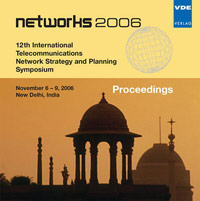Economics of Cellular and Wireline Voice Convergence - What are the services and strategies, and does it make economic sense?
Conference: networks 2006 - 12th International Telecommunications Network Strategy and Planning - Symposium
11/06/2006 - 11/09/2006 at New Delhi, India
Proceedings: networks 2006
Pages: 8Language: englishTyp: PDF
Personal VDE Members are entitled to a 10% discount on this title
Authors:
Borger, James; Krishnan, Yadhav; Bass, Mark; Cleary, Pierce; Kanu, Iheanyi (Bell Laboratories, Lucent Technologies, Holmdel, USA)
Abstract:
Cellular and Wireline (WiFi VoIP & VoIP over wired broad band) Convergence is being driven by the value a unified wireline/wireless service brings to the end-user (consumer, enterprise) and operator. Convergence can provide the end-user a seamless user experience between mobile and fixed environments (home, office), increased convenience, higher productivity, better coverage, and potentially lower prices. From the wireless service provider perspective, it provides an opportunity to differentiate services, lower costs, reduce churn, and increase revenues. From the wireline service provider perspective the converged offer is the best hope of stemming the decline to the voice wireline business as customer migrate to wireless. Although, operators realize the value of providing a converged Cellular/Wireline service they are looking for clear business and economic drivers for the services they plan to offer. Using voice convergence case studies, this paper presents a business modeling analysis to evaluate: a) the end-user value proposition for new Cellular/Wireline service, b) Solution alternatives for providing Cellular/WiFi services, and c) the wireless operator’s value proposition for providing Cellular/Wireline services. We have developed models to understand and analyze the pricing and market demand for the converged services and the end-user value proposition. The results of the end-user modeling and market demand analysis is incorporated in, and drives, the operator business model. There are primarily two solution alternatives for providing Cellular/WiFi service, a) IMS based solution or b) UMA based solution. The case study shows that the IMS based solution has significant financial advantages over UMA solution, taking into consideration evolution to 3G and extensibility of the IMS solution to support multiple applications. Results of the business case analysis show that Cellular/Wireline service has an attractive value proposition for both the end-user and operator. The sensitivities of key parameters and their impact are highlighted to provide a clear understanding of the critical factors driving the business case.


